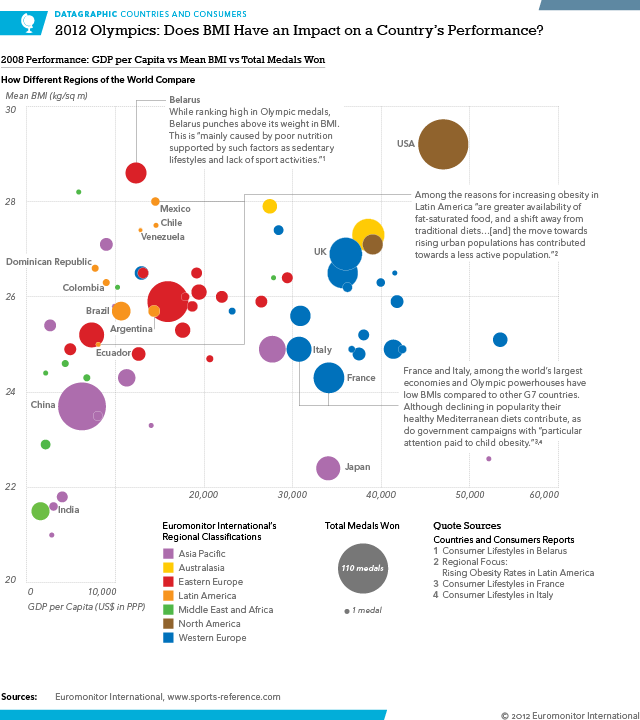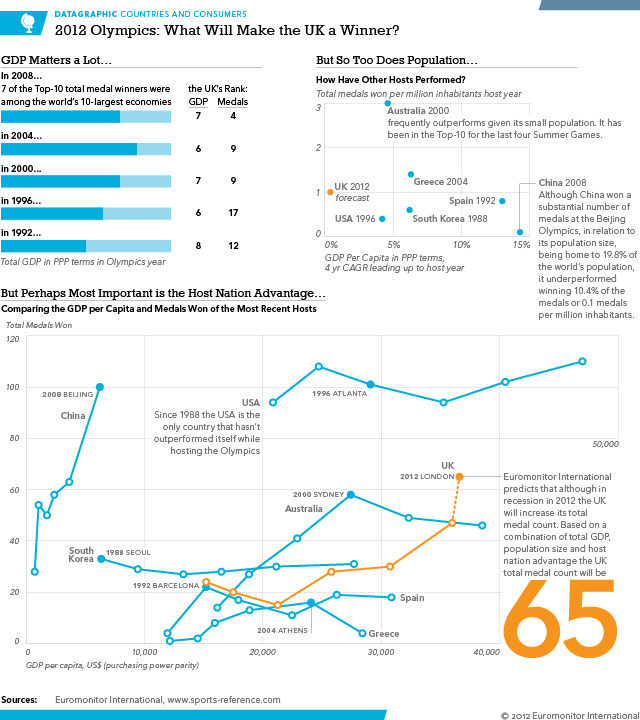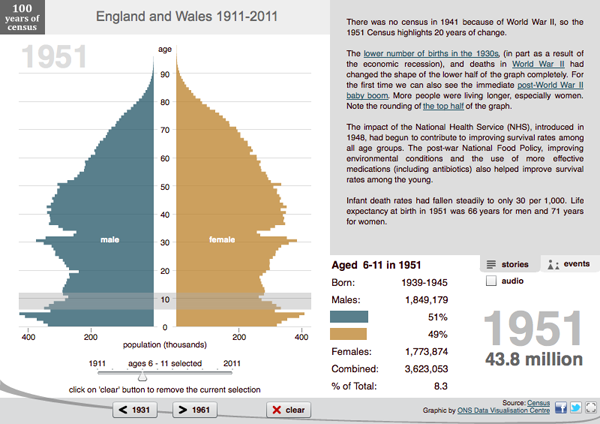In this infographic about campaign ad spending in three battleground states, the New York Times shows that small multiples can work to create effective comparisons through an efficient use of space.

In this infographic about campaign ad spending in three battleground states, the New York Times shows that small multiples can work to create effective comparisons through an efficient use of space.

Mexico has some serious problems. Primarily with the drug cartels. About two weeks ago the National Post created an infographic that looked at the northern spread of Mexican drugs into the United States. The infographic also included details on the transit and transportation networks the different drugs take along with the geographic spread of the various cartels from the Tijuana, Federation, Juarez, and Gulf Cartels as reported by US cities.
Foreign Policy magazine rates countries as to how close they may or may not be to becoming failed states. Mexico is among those that have fallen into the “Warning” category over the recent years. The second half of the infographic looks at why. In short, in the past few years over 50,000 people have been killed in drug-related homicides and several more thousand have simply disappeared. The police, military, civilian officials, journalists, &c. have become targets of the cartel if they oppose the cartels.
Mexico has some serious problems. Sadly problems have a tendency to spill over borders.

Credit for the piece goes to Jonathan Rivait and Richard Johnson.
A lot of people’s minds may be on the Olympics that open up today in London. However, a very important story that was covered a little while ago deserves a post.
The United States has been suffering from a severe drought across much of the country. Droughts are nothing new, though climate change is likely to increase their intensity in the coming decades. This means more than lawns with dead grass; it means crop failures. Crop failures mean lack of food for humans and cattle. That means lower supply while demand holds steady. That means increasing prices. That means increasing pressure on already straining household budgets. Ergo, severe droughts can be a big deal.
The New York Times charted the geographic spread of droughts over the past century as small multiples. The print version was different, alas I have no photo, but the online version neatly groups maps by decade. Of some interest is how similar the scale of the 2012 coverage is in relation to that of 1934, the year of the Dust Bowl.

Credit for the piece goes to Haeyoun Park and Kevin Quealy
It turns out not so much. A comparison of the 2008 data for average BMI (coarsely how fat a person is) for countries across their economic productivity (GDP per capita) and total medals won shows that a country’s health culture does not greatly impact said country’s Olympic chances.

This is another from my work series on infographics for the Olympics.
In a small piece, the New York Times looks at the ramifications of the Supreme Court’s decision to uphold the Affordable Care Act. Fewer people are insured and total cost for the programme falls.

Bradley Wiggins won the Tour de France over the weekend; he is the first Briton to do so since the Tour began in 1903. (But to be more accurate, Wiggins was born to an Australian man and English mother in Belgium.) Naturally the BBC covered this topic in an infographic focusing on the nationality of those who finished in the Top-10 of the Tour over the course of its history.

Except when I first saw this I was confused. So far as I understood, the Tour is not run by individuals (as in the Olympics) or by national teams (as in European “football”). Rather, it is more like Formula 1 racing with individuals as part of a corporate team. So naturally I expected to see which teams had won. Instead I was looking at “by country”.
This I then figured meant by position within the Top-10 as each person/position is clearly segmented. That sort of made sense as I looked at the first few rows and saw red (America) and I recalled the success Lance Armstrong enjoyed. But that sense fell away when I reached the end of the list that should have had Frenchman in the top. It turns out that the legend for the piece dictates the order of the nationality of the winners of the Top-10 without respect to their actual placement. That perhaps could be a bit clearer.
The colours sort of make sense as groupings of countries. Blue groups the Benelux + France whereas red groups English-speaking countries. Orange for Italy and yellow for Spain while green groups former Soviet states and grey/black appears to be a collection of the rest.
Further down the rows, I ran into a smaller problem in that the number sequence seemed a bit out of sorts. The Tour was cancelled during the World Wars, but no mention of that is made in the graphic itself.
A worthwhile graphic—after all who does not want to see their country winning?—but its labelling could stand a bit higher finish.
The Olympics are coming, the Olympics are coming. (As if you didn’t know.) In a rare moment of seeing my work outside of my company’s paywall, I can post a few infographics I have created for the 2012 Summer Games in London. The series looks at a few different non-Olympic variables like GDP per capita and mean BMI and sees whether they impact total medal counts in the Olympics.
This first datagraphic (to use my company’s internal language) looks at what makes a winner and will the UK be one this summer. The main chart in the piece compares GDP per capita performance to total medal count in each Olympic year from 1988 to 2008. And yes, we are predicting the UK to win a total of 65 medals this summer.

In the interest of full disclosure, I work as the senior graphic designer for Euromonitor International. This series was not intended to be used as part of marketing/promotional piece (I probably need to include the link to download that document here), but instead I designed them all as client-only content. But since others decided to use my work as marketing material, I am fortunately allowed to share it with all of you via my blog. So yeah, that’s pretty cool. Enjoy.
Census data fascinates me from a data visualisation perspective; one can look at it so many different ways. Last week I looked at some of the Slovakian census data on the Carpatho-Rusyns that live in the northeastern mountains of Slovakia. But yesterday, the British Office of National Statistics released the results from their census of England and Wales (Scotland reports later and Northern Ireland did so already, yay devolution.) One of the big news stories was that England and Wales had 500,000 more people than had been expected. That doesn’t sound like a lot of people, but to put it roughly into American proportions, that would be like finding that there was a whole new city the size of Chicago somewhere in the United States.
But while many organisations and individuals will certainly be looking at the census data in the coming days, weeks, and months, the ONS released its own interactive application. Basically it looks at the population pyramid for England and Wales from 1911 to 2011, a century’s worth of data. But what makes this different from the GE population pyramids, for example, is the context that the ONS has added that strict data pulls lack.

Here in 1921, rolling over a particular cohort reveals the details of those aged 30 in 1921. There is a clear difference between the number of men and women. But why? The text block’s first note details how 700,000 men aged 20–40 died during World War I and thus altered the basic structure of the English and Welsh population.

And in 1951 we begin to look at the British baby boom in the post-war era. Again, while the Baby Boom might be expected, the ONS also points out that the NHS, the British National Health Service, had also recently started and was positively affecting life expectancy and the general health of the British public. These are again things that would not likely appear in more data-focused pieces.
But everybody loves to compare things to other things. So, the ONS also released a more data-focused application that allows the user to select two different census geographies and compare them. This is more as one would expect, comparing overlays vs. side-by-side looks at different population pyramids. The example below compares London to Birmingham.
Credit for the pieces go to the ONS Visualisation Centre.
The BBC is letting you see how fat you are. They take inputs of age, weight, gender, and then your country of residence to compute your BMI and compare that across multiple countries for which the data exists. It compares you to your national average and then provides a country whose average best fits your BMI.

My 300lb., 6’0″ avatar is apparently overweight. And most like someone from Micronesia.
The Slovakian government has published the results from its 2011 census. The census looked at many things, including nationality and language. This should allow the government in Bratislava to better fund and support the ethnic minorities in Slovakia.
Of course, some of my ancestors were one of the small ethnic minorities in Slovakia. Ergo, I have a personal interest in the data. The result is a quick infographic about the Carpatho-Rusyns of Slovakia. Click on the cropping below to learn more, meaning, see a bigger and fuller version.

Credit for the work goes to me. For the data, the statistics office of Slovakia.